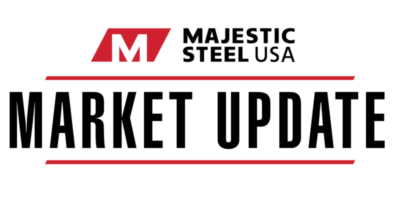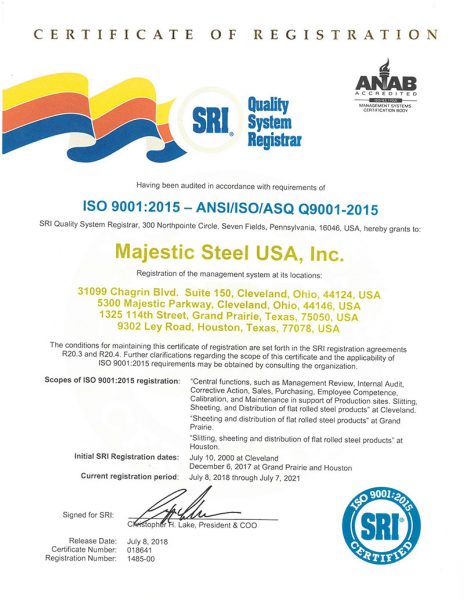Market Update | March 16, 2022
Supply Distruptions continue to impact the market
Supply disruptions in Russia and Ukraine continue to impact global input prices. Skyrocketing energy prices in Europe are causing zinc prices to rise. It is very likely that mills will continue to announce coating extra increases because of this. Business activity in New York is also feeling the impact of supply disruptions. The Empire Manufacturing Index saw declines in new orders and shipment components and an increase in the unfilled orders.
Input Costs
Zinc pricing held relatively steady this week after the sharp increases the previous two weeks.
- Multiple mills have announced new coating extra increases and there may be further increases in the near term.
- Upward momentum for zinc pricing could push pricing closer to $2.00/lb., which last happened in late 2006.
- Skyrocketing energy pricing is affecting smelters around the globe, particularly in Europe, which has helped to push the price higher.
- Spot iron ore pricing softened this week, sliding to $135.55/mt.
- Spot iron ore pricing is down 16.5% w/w but back below prior year levels.
Met coal pricing continues to see significant price increases as well, with Pacific basin met coal pricing climbing to a fresh all-time high.
- Met coal pricing increased to $671/mt this week, up 9.1% from last week and 51.5% from this time last month.
Supply
Domestic raw steel production declined slightly last week after a slight increase previously.
- U.S. steelmakers produced 1.737 million tons at a 79.9% utilization rate.
- Year-to-date production is 0.4% above the total from the same period last year.
Demand
Business activity, in the New York region, declined for the first time since early on in the pandemic in March.
- The Empire Manufacturing Index came in at -11.8, its lowest level since May 2020.
- Any reading over 0.0 indicates growth, while any reading below 0.0 denotes contraction.
- Both the new orders and shipment components declined in March.
- The new order and shipment components declined to -11.2 and -7.4, respectively.
- While these two components decline, the unfilled orders component continued to increase, coming in at 13.1.
- Despite the decline in March, respondents were generally optimistic about the six-month outlook.
- The index for future business conditions climbed sharply to 36.6 from 28.6 previously.
Confidence among U.S. homebuilders slowed in March as building material prices increase, mortgage rates are on the rise, and home prices continue to push higher.
- The March Housing Market Index came in at 79, down slightly from 81 in February and below the 82 reading in March 2021.
- Any reading over 50 indicates increased optimism from U.S. homebuilders, while any reading below 50 denotes pessimism.
- While optimism from the present situation and next six months components slowed slightly, builders saw an increase in traffic in March.
- The traffic component increased to 67 from 65 in February and ended a string of two consecutive monthly declines.
Price
According to Platts, HRC pricing around the globe continues to see an uptick after the recent disruption to supply from Russia and Ukraine.
- Spot HRC prices in Northern Europe has increased sharply on the back of lower Russian and Ukrainian supply and a sharp increase in raw material costs.
- Current HRC pricing for Northern Europe is $69.60/cwt.
U.S. HRC futures have increased significantly over the last two weeks.
- The current 3-month contract (June) is at $1,650 today; up from $965 four weeks ago.
- This is a 70%+ increase.
Economy
According to the February Cass Information Shipment/Expenditure report, U.S. freight volumes rebounded after a sharp decline in January.
- The shipment component of the Freight Index increased 8.6% from January and was up 3.6% from February 2021.
- The impacts from the Omicron variant, that impacted January’s reading, lingered into February, so its expected that March should move even higher.
- The expenditures component, which measures the total amount spent on freight, increased a sharp 10.6% in February.
- Higher shipment volumes, combined with higher rates, helped to push the expenditures component higher.
- Expenditures divided by shipments produces inferred freight rates, which measures movement in cost per shipment.
- The inferred freight rates continued to climb, up 1.6% from January.
- Freight rates are only going to increase sharply from here as diesel is now over $5.00/gallon.
After slipping in December, U.S. retail sales started 2022 off strong by increasing in both January and February.
- February retail sales came in at a $658.1 billion rate, up 0.3% from January and up a sharp 17.65 from a $559.6 billion rate in February 2021.
- However, excluding spending at gas stations, total spending slipped slightly in February.
- The largest month-over-month increases in spending came from gas stations, bars and restaurants, sporting good stores, and clothing stores.
- These increases helped to overcome declines seen at online retailers, health and beauty stores, furniture stores, and electronic stores,
U.S. producer prices increased 0.8% m/m in February, bringing annual producer inflation to 10% y/y, which marks the highest level since 1981.
- Goods producers faced a wave of double-digit increases for their input prices and distribution costs, with processed input prices up 23.3% y/y and unprocessed input prices spiking 35.1% y/y.
- The costs of transporting and warehousing finished output jumped 17.0% y/y.
This material, information and analyses (the “Content”) may include certain statements, estimates and projections prepared with respect to, among other things, historical data and anticipated performance. Content may reflect various assumptions by Majestic Steel USA, Inc. concerning anticipated results that are inherently subject to significant economic, competitive and other uncertainties and contingencies and have been included for illustrative purposes. Content is provided AS-IS.

